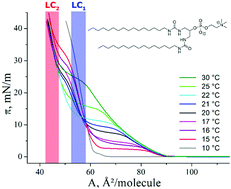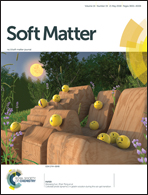Against the rules: pressure induced transition from high to reduced order†
Abstract
Envisioning the next generation of drug delivery nanocontainers requires more in-depth information on the fundamental physical forces at play in bilayer membranes. In order to achieve this, we combine chemical synthesis with physical–chemical analytical methods and probe the relationship between a molecular structure and its biophysical properties. With the aim of increasing the number of hydrogen bond donors compared to natural phospholipids, a phospholipid compound bearing urea moieties has been synthesized. The new molecules form interdigitated bilayers in aqueous dispersions and self-assemble at soft interfaces in thin layers with distinctive structural order. At lower temperatures, endothermic and exothermic transitions are observed during compression. The LC1 phase is dominated by an intermolecular hydrogen bond network of the urea moieties leading to a very high chain tilt of 52°. During compression and at higher temperatures, presumably this hydrogen bond network is broken allowing a much lower chain tilt of 35°. The extremely different monolayer thicknesses violate the two-dimensional Clausius–Clapeyron equation.



 Please wait while we load your content...
Please wait while we load your content...